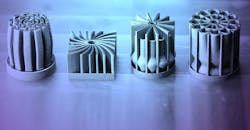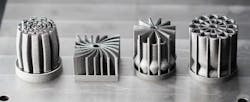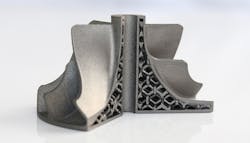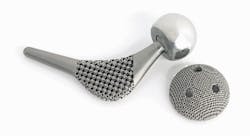3D Metal Printing: Tips, Trends, and Common Misconceptions
When it comes to low-volume manufacturing of metal parts, 3D metal printing is set to propel the market forward and disrupt the status quo. There is a lot of buzz around the technology, and rightfully so. However, it has limitations that cannot be overlooked.
It is also obvious, especially to those on the on the production side of the business, that there is a learning curve that will have to be overcome before 3D metal printing can reach its full potential. However, first it’s important that engineers have a keen understanding of the process before they design for it.
Metal Printing Methods
At present, the three most common methods of 3D metal printing are direct energy deposition (DED), powder bed fusion, and binder. Each has its nuances and has found its own niche in the market. It’s important to understand that 3D metal printing is much more complex than 3D plastic printing. Given its intricacies, printing metal parts will likely always be conducted in a manufacturer setting due to precautions that need to be taken with certain metal powders.
DED sends a spray of powdered metal through a nozzle. The tightly focused “beam” of powder is struck by a laser which fuses the powder into a solid at the point of deposition. This can also be done using metal wire, but metal powder is more common.
As in most 3D printing processes, deposits are laid down layer by layer to build the desired part. DED is suitable for quickly printing large, low-fidelity parts. It can also be used for spot-repairing components.
Binder jetting is unusual in that it works with sand and ceramic powders as well as metal powder. This process sprays a liquid binding resin directly on the powdered material. The resin solidifies the powder to create the desired part. It’s fast, relatively cost-effective, and can be used to create large structures.
It is important to note that this process is not suited for engineering applications because without additional post-processing, binder jetted parts have low densities and strengths. Post-processing adds to production time and costs, but some post processing—such as curing and infiltration—is done to some industrial-grade materials to improve the density and strength of the binder jetted part.
Powder bed fusion is perhaps the most popular metal printing process. It includes direct metal laser melting (DMLM), which uses a powder bed and a laser that melts and fuses those powders into layers on a build platform. This is a slower process than DED and requires more careful design, but generally result in stronger, more-durable parts.
Each of these techniques can be used to great effect. However, metal printing in general is widely misunderstood due to the lack of design-for-manufacturing knowledge.
3D Metal Printing Misconceptions
3D metal printing has gained a false reputation as a catch-all for designs that cannot be turned into finished products by other manufacturing processes and technologies. But 3D metal printing is not a “rescue operation” and won’t be able to save a flawed design. As a low-volume manufacturer offering 3D metal printing services, Star Rapid receives many inquiries specifically because a design did not work with other manufacturing processes. Most designs received cannot be printed “as is” and require significant design changes for metal printing.
Another common situation arises when potential customers want parts designed for 3D plastic printing to be printed in metal. Metal printing and plastic printing are not interchangeable processes. Metal printing is much more complex, requiring more design education and forethought.
Another common misconception is the preference to choose metal printing over traditional (subtractive) practices such as CNC machining. If parts can be made using subtractive manufacturing, then those processes should be used. CNC designs, for example, tend to have much more volume, which makes metal printing inefficient. On top of this, designs optimized for CNC machining cannot be “run through” a 3D metal printer. Supports need to be added and other factors (excess heat and post-processing) need to be taken into account, which oftentimes would significantly alter the original design.
For instance, the longer it takes to print a metal part, the higher the chances it will fail. There will be a great deal of internal stress created during the repeated heating and cooling that must take place. The more time it takes to build the part, the more likely the part is to distort during the printing process due to its large volume, and those internal stresses will increase up over the build time; stresses cannot be relieved during metal printing.
When the internal stress is great enough, the part will distort and the build will fail. (Tip: Adding conformal cooling channels when designing metal-printed parts is one way to increase the parts’ resistance to thermal stress.) At this time, CNC machining is still faster and more cost-effective than metal printing.
3D Metal Printing Pros and Cons
Like any technology, metal printing has its advantages and disadvantages. The trick is to know both when it is appropriate to use it and the ideal applications for the process. For example, metal printing is a good option for creating complex parts that need to be strong and lightweight. Metal printed parts are also fully dense and can include precision internal features that cannot be created using traditional machining. Printing is additive, so it generates minimal waste.
Another benefit of 3D metal printing has to do with its reliability. Although it may take a few attempts to find the best parameters, design, and orientation for building a part, once discovered (and documented), the process is tremendously consistent. It will result in the same part every time, build after build. Although this may be assumed as a given for any manufacturing process, the predictability and efficiency of metal printing should never be overlooked.
The tradeoff to 3D metal printing’s benefits is that speed and cost cannot be driving factors for those who want to pursue this technology. This is why the aerospace and automotive industries have been the most committed early adopters of the technology. The lightweight, strong designs translate well to their applications.
There is a lot of evidence showing that the demand for 3D metal printing is being driven by high-end applications.
Build times for 3D metal printing are longer compared to those for plastic 3D printing. It also typically requires several builds to fine tune a part’s design for mass production through 3D metal printing.
Before committing to designing parts for metal printing, designers should consider the material that is preferred for the part. Although there are a lot of materials people claim can be used for 3D printing, there is a very limited number of metals that can be printed on the market. It takes years of research and effort to develop the process parameters for specified materials in certain machines. This is a tricky aspect of the technology.
Processing parameters depend on the machine used, meaning there is no one-to-one comparison between two metals or materials.
Some of the most common and reliable metals for 3D printing include stainless steel, aluminum, titanium, cobalt chrome and Inconel alloy. Choosing the best material is vital for ensuring parts will perform as needed.
For example, tainless steel (SS-316L) has high hardness and toughness. It is highly machinable and can be highly polished. It is commonly used for pressure die casting molds, surgical tools, and general engineering parts. Aluminum (ALSi10Mg) has low density, which makes it well suited for lightweight components. It also has a high thermal and electrical conductivity, making it attractive for automotive, aerospace, and electronic cooling applications.
Another design aspect to consider before going with choosing 3D metal printing is the desired surface finish. The surface finish of 3D printed part is poor due to it being built layer by layer. It takes post-machining on printed parts to get aesthetically pleasing surface finishes. This can be done using CNC machining or manual surface grinding, sanding, or polishing.
However, that nice finish is limited to areas accessible by finishing tools, and those can’t be areas where parts are too thin or complex.
It may seem obvious, but size is another limed parameter. Parts cannot be larger than the machine’s build platform, which varies from printer to printer. Although there is no standard Build-platform size, the most common dimensions are around 250 × 250 × 300 mm. Small machines have build platforms of roughly 100 × 100 × 80 mm and large machine platforms are roughly 400 × 400 × 380 mm.
Although 3D metal printing is not as easy as 3D plastic printing, the process of perfecting a design is worth it due to the higher engineering standard of the process.
Tips for Sound Designs
With metal printing, there is a fair amount of trial and error that goes into perfecting a design. However, there are some common design pitfalls that can be avoided to streamline the process. It’s important for designers to have the process in mind when creating CAD models. Different 3D metal printers have different limitations due to the laser spot size and melt pool. Despite this, there are some general guidelines that should be followed when designing parts for metal printing:
Wall thicknesses. Walls that are too thin will begin to collapse under their own weight. Walls should be no thinner than 0.5 mm.
Holes and gaps. The limitations for gaps and holes may vary widely based on the printer being used, the metals being used, and part geometry. The general rule of thumb is to not design a gap or hole under 0.5 mm. Smaller gaps run the risk of the sides merging together and filling the empty space. On the other hand, supports need to be added for holes greater than 10mm.
Overhangs: 0.5 mm is the maximum length that should be used for an overhang, and all downward facing structures need to be designed to a chamfer (more than a 45-deg. angle to the horizontal), with a concave or convex shape so the part can support itself. Support structures need to be included in the part’s design to exceed these guidelines.
Support generation. Supports are needed for two reasons. The first is to hold parts to the substrate plate. The second is for heat dissipation. Any areas below 45 deg. from horizontal need supports added. This applies to most of the metals. However, there are exceptions. Ti64 (an alpha-beta titanium alloy) parts can have walls angled be as low as 30 deg. without supports.
Part orientation. Unlike other manufacturing processes, 3D printing creates parts with anisotropic properties, which means they have different mechanical properties in different build directions. In the X and Y directions, for example, parts have higher tensile strength than they do in the Z direction. Hence, part orientation needs to be considered prior to printing. This is especially true if parts are for mechanical/structural purposes where a certain area will sustain some degree of pressure and stress.
There is also an aesthetic element to part orientation. Downfacing surface areas of printed parts will have a poorer surface finish compared to the top-facing surfaces. If certain areas of a part need better surface finishes, it should be taken into consideration during part orientation. For complex parts, it is important that part orientation is such that if there are supports that may affect part function, they can be removed.
Trends in Metal Printing
In the near future, hybrid additive/subtractive machines will find their niche. It is not uncommon to find metal printing and CNC machining as part of a single production line. CNC machining may be needed to remove supports added to make a printed metal part. With a plastic printed object, supports can sometimes be manually removed simply by snapping them off. This is not the case with metal printing where removing supports takes a significant amount of time and effort. Once supports are removed, surface work (a time-consuming process) may be required as well.
Combining these processes in one machine could be beneficial.
There may also be some fine features of a design that require CNC machining. For example, if threads are needed on a printed part, it is best to CNC them to ensure they will work. Combining metal printing and CNC machining would be a great addition to any low-volume manufacturer’s factory floor.
Although combined additive and subtractive machines will grow the market, traditional 3D metal printers will as well. Although there may seem to be a lot of limitations when it comes to metal printing, the industry fully expects the technology to go mainstream. It can be used to build parts that would be impossible by any other process due to complexity. The key to metal printing’s growth and adoption will depend on widespread knowledge of designing parts for 3D printing. Some responsibility will fall on manufacturers to find avenues to share their knowledge with designers and one another.
The second major obstacle the technology faces of longer build times will begin to dissolve as new generations of metal printers come to market and the technology is perfected. Time will also lead to a wider range of metal powders to use for the process. Overall, 3D metal printing will likely prove to be the greatest development in low-volume manufacturing of metal parts over the next 50 years.
Free Training in 3D Metal Printing
Star Rapid, a global rapid prototyping, rapid tooling, and low-volume manufacturer, is providing free resources and tools to teach the engineering community proper design for 3D metal printing. This will include the development of a 3D metal printing online video library as well as three-day workshops at Star Rapid’s headquarters in China.
“The quick emergence and complexity of 3D metal printing has created a massive design-process deficit within the industry,” notes Gordon Styles, founder and president of Star Rapid. “As a manufacturer, we are well positioned to share best practices and lessons learned on this subject as we’ve seen first-hand how hard it can be to develop the correct design parameters for a build. Greater widespread design knowledge will help unlock the full and boundless potential of 3D metal printing for more widespread application.”
The company has already launched a series of videos that promote the value of 3D metal printing and its potential to create strong, innovative parts with less waste. Most importantly, the tutorials provide valuable knowledge on how to design for manufacturing and avoid various common design pitfalls that have emerged due to differences between metal and plastic printing, and traditional manufacturing techniques such as CNC machining.
The first three video tutorials are now available online on Star Rapid’s website. The Designing for 3D Metal Printing videos series include: “Episode 1: Introduction to Designing for 3D Metal Printing”; “Episode 2: Walls, Gaps, and Holes”; and “Episode 3: Bridges and Overhangs”.
Star Rapid is also offering face-to-face and hands-on training at its 60,000-sq.-ft. manufacturing facility in Southern China. The training will let attendees design a part, receive feedback from the company’s 3D printing experts, and print the part using a DMLM Renishaw printer. Training courses are planned for later this year from August 14 to 16 and November 6 to 8, as well as next year from March 14 to 16.
For more information on the training course and access to the videos, click here.





